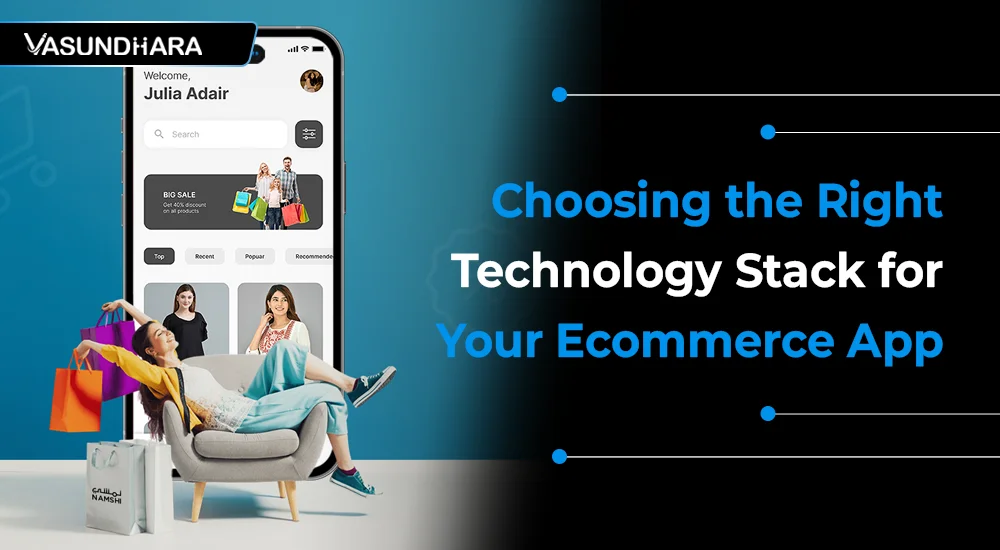Choosing the Right Technology Stack for Your Ecommerce App


- Nov 9, 2023



Ecommerce has become an essential aspect of our daily lives in today's digital world, and we can’t underestimate the power of custom software in ecommerce landscape.
Businesses are continuously attempting to create seamless and engaging user experiences through their ecommerce apps in order to meet the ever-increasing demand for online purchasing.
The importance of technology selection in terms of user experience and commercial performance cannot be emphasized.
A well-designed technological stack can result in a responsive and user-friendly app that not only attracts and maintains users but also aids in the growth of your organization.
Poor technological decisions, on the other hand, can lead to sluggish performance, security flaws, and an inability to scale efficiently.
The goal of this blog is to help you make informed technology stack decisions for your ecommerce project.
We'll go over the major considerations, popular technology stack options, customisation and integration possibilities, mobile app creation, testing and quality assurance, maintenance, and upgrades.
Ecommerce applications are digital platforms that facilitate the online sale of goods and services by businesses.
They function as the digital portal for clientele, offering them a practical means to peruse, choose, and acquire products from the comfort of their own residences.
Ecommerce applications, which provide an extensive variety of products, services, and features customized to meet the demands and expectations of contemporary consumers, have emerged as the foundation of the retail sector.
Standard ecommerce applications consist of a variety of functionalities that are specifically engineered to improve user satisfaction and stimulate revenue. Such features might consist of:
The technology stack provides the structural support for every feature and function of an electronic commerce application.
It determines the application's responsiveness to user actions, security against potential hazards, and overall usability.
The selection of the technology platform has an impact on various aspects of the application, including the custom ecommerce application development, build and deployment time, and adaptability to dynamic market conditions.
Choosing the right technology stack for your ecommerce app development is a crucial decision that can significantly impact the success of your online business.
To make an informed choice, you need to consider several important factors. Here are the key factors to keep in mind when selecting a technology stack:
It is critical that your technology stack is scalable in order to facilitate the expansion of your business. Over time, consider the anticipated increase in user traffic and transactions.
A meticulously selected stack ought to possess the ability to endure augmented burdens without compromising its performance.
Your technological decisions may be substantially impacted by financial constraints. Continual maintenance, licensing, and development expenses can vary substantially based on the technologies selected.
Evaluate the financial resources at your disposal and compare them to the anticipated return on investment (ROI).
Gaining a comprehensive understanding of your intended market and audience is vital. Various markets may exhibit distinct preferences and behaviors that exert an impact on the determination of technology stacks.
Localization, currency support, and language options should be taken into account in order to accommodate a global audience.
Critical in the fast-paced world of ecommerce is the time-to-market.
Select a technology platform that facilitates swift development and deployment in order to attain a competitive advantage.
Ensuring the adaptability of one's technology stack to emergent trends and technologies constitutes future-proofing.
A stack that facilitates integrations and updates can assist your application in remaining competitive and pertinent over time.
The core components of an ecommerce technology stack play a vital role in shaping the performance, functionality, and security of your online store. Let's explore these components in more detail:
HTML, CSS, JavaScript: HTML, CSS, and JavaScript form the backbone of the front-end of an ecommerce app. They are essential for creating the user interface, designing web pages, and adding interactive elements.
Frameworks and Libraries (e.g., React, Angular, Vue.js): Frameworks and libraries offer pre-built components and tools that expedite development. Examples include React, Angular, and Vue.js, which enhance the user experience and streamline development.
Server-side Languages (e.g., Node.js, Python, Ruby): The back-end is responsible for data processing, server management, and ensuring smooth interactions between the front-end and the database. Choose a server-side language that aligns with your development team's expertise and the app's requirements.
Databases (SQL vs. NoSQL): Databases store product information, customer data, and transaction records. SQL databases are known for their data consistency, while NoSQL databases provide flexibility and scalability. Choose the type of database that suits your app's data needs.
Cloud Services (e.g., AWS, Azure, Google Cloud): Cloud services provide scalable, reliable, and cost-effective infrastructure for hosting your ecommerce app. Services like AWS, Azure, and Google Cloud offer a range of solutions to suit different needs.
Content Delivery Networks (CDNs): CDNs optimize the delivery of content to users by caching and serving data from servers located closer to the user's geographical location. This results in faster load times and improved user experience.
Choose secure payment gateways and implement robust security measures to protect user data and transactions. Ensure compliance with industry standards and regulations, such as PCI DSS, to maintain user trust.
A prominent ecommerce platform, Shopify, employs a technology stack consisting of React for the front-end, Ruby on Rails for the back-end, and AWS for hosting. By combining these components, a dependable, scalable, and user-centric ecommerce solution has been successfully implemented.
A technology architecture comprising PHP for server-side scripting, WordPress as the content management system, and MySQL for the database underpins the popular WordPress plugin WooCommerce. This amalgamation is renowned for its adaptability and potential for personalization.
Every technology system possesses its own set of benefits and drawbacks. Ruby on Rails and React, which are integrated into Shopify, provide a vast array of features and superior scalability, but they can be pricey.
The PHP and WordPress framework utilized by WooCommerce is customizable and economical, but it may necessitate additional development effort.
To meet the goals of your business, customization is very important. You can make your e-commerce app do more by adding apps and APIs.
APIs let you connect to third-party services, while plugins can add new features.
It is normal in ecommerce to connect to third-party services like shipping providers, payment gateways, and analytics tools.
It's important to make sure that your e-commerce app fits with your business and user preferences.
Make sure the technology stack lets you be flexible with design and usefulness. This will make it easier to give each user a unique experience.
In order to expand the reach of your web platform and elevate user engagement, it may be prudent to contemplate the development of a supplementary mobile application.
By creating a single application that operates on multiple platforms, cross-platform development reduces both the time and cost of development.
Conversely, the process of developing native applications provides enhanced efficacy and a more streamlined user experience.
If you choose cross-platform or native development, the technology architecture you choose for your mobile application will vary.
For mobile application development, prevalent technologies include React Native, Flutter, and Swift.
It is important to test your app to find and fix problems that could affect its speed, security, or the user experience.
Full testing makes sure that your app does what it's supposed to do and makes shopping easy.
To check different parts of your technology stack, use a range of testing methods and tools, such as unit testing, integration testing, load testing, and security testing.
Check your e-commerce app's performance often and make changes as needed. Performance tuning makes sure that your app stays quick, safe, and able to meet user needs.
Maintaining and upgrading your ecommerce app technology is an ongoing process that is critical to its success.
Neglecting these aspects can lead to security vulnerabilities, performance issues, and an inability to accommodate your business's growth. Here are key considerations for maintenance and upgrades:
Technology evolves rapidly, and it's essential to keep your technology stack updated.
Plan for regular maintenance and software updates to patch security vulnerabilities and take advantage of new features and improvements.
Security is paramount in ecommerce. Stay informed about security vulnerabilities in your technology stack components and promptly apply security patches to protect user data and maintain trust.
As your business grows, you may need to scale your technology stack to handle increased traffic and transactions. Ensure that your technology stack is flexible enough to accommodate growth.
In conclusion, choosing the right technology stack for ecommerce app development is a critical decision that significantly impacts the success of your online business.
The impact of technology stack choices on the success of an ecommerce app cannot be understated.
Your chosen stack should align with your business goals, budget, and the expectations of your target audience.
It should support scalability, security, and performance, and offer room for future growth and adaptability.
The expertise of experienced developers and technology consultants can help you make informed decisions that set your business on the path to ecommerce success.
If you're looking for a reliable partner to develop your ecommerce app, consider Vasundhara Infotech.
With a team of experienced developers, Vasundhara Infotech can assist you in making the right technology stack choices, customizing your app, and ensuring that it performs flawlessly.
Request for quotes and take the first step towards creating an outstanding online shopping experience for your customers.
Don't let your ecommerce app's success be determined by the wrong technology choices.
Contact us today for expert guidance and custom ecommerce application development services to ensure that your ecommerce app is built on a solid foundation that supports your business goals and delivers an exceptional user experience.
Copyright © 2025 Vasundhara Infotech. All Rights Reserved.